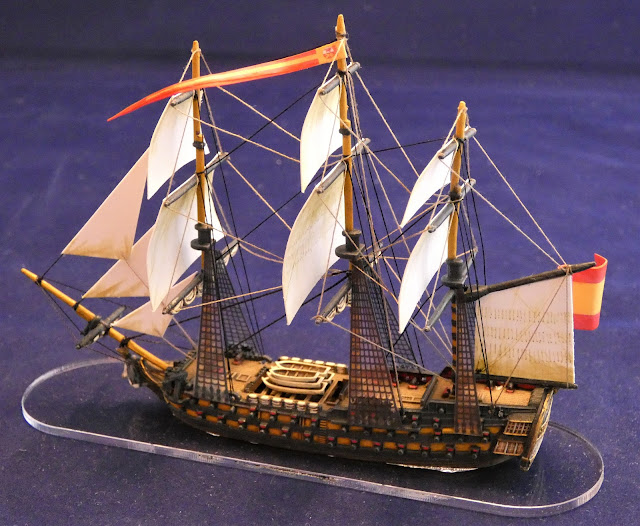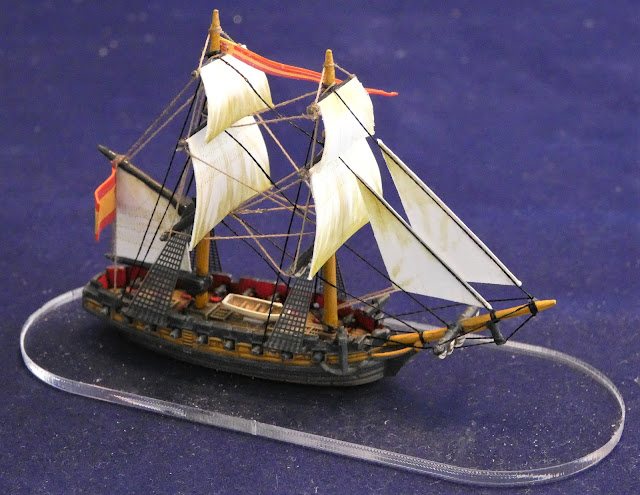 |
| "Wind, Sails and Flags" - Carlos Parilla Penegos https://www.carlosparrillapenagos.es/pintura-naval/cuadros-1/ |
A couple of weeks ago, I finished work on the Spanish squadron for fellow clubmate Jack, which, together with similar builds for my other clubmate Bob, has brought to a conclusion a project worked on over the previous eighteen months, with a four month break to go travelling in October 2022 to February 2023.
If you want to look back over this project I have attached the links below:
 |
As well as putting the models together Jack asked me to prepare similar storage and basing to my own collection.
 |
| The links to the base sizes by rating are in this link, just scroll to the bottom of the post. JJ's Wargames - All at Sea - On the Stocks in JJ's Dockyard |
Likewise I constructed the insert trays from Sally 4th, designed to fit the 9 litre and 19 litre European Really Useful Boxes, which with the inclusion of some thin 2mm bamboo batons in the bottom of the trays, allows the models to be safely stored and carried to and from games.
 |
| Sally 4th - RUB Tray |
So this set of Spanish models is built from the Spanish Navy Fleet box collection from Warlord Games and Jack asked me to build the generic first-rate, 112-guns, the three named third-rates, San Juan Nepomuceno 74-guns, Neptuno 80-guns and Montañés 74-guns, two of the three frigates, Ceres 40-guns and Diana 34-guns, and one of the six generic brigs.
Below we have the mighty Spanish first-rate of 112-guns which was standard for the 'Meregildos' class of ship during the Napoleonic era, designed to carry a crew of some 1,100 men, and armed with 30 x 36-pounder long guns on the lower gun deck, 32 x 24-pounders on the middle deck and 32 x 12-pounders on the upper deck, rounded off with 18 x 8-pounders up on the quarterdeck and forecastle.
 |
| The Santa Anna and Principe de Asturias take on supplies in Cadiz, two fine examples of the 'Meregildos' class. |
'Meregildos' First-Rate, 112-guns
The three third-rates share their history as they were all part of the Combined Fleet at Trafalgar, starting below with perhaps the most famous of them, for its heroic fight during the battle, San Juan Nepomuceno and the death of its outspoken commander, Commodore Don Damián de Churruca.
 |
Commodore Don Damián de Churruca |
Churruca, who on witnessing the signal from Vice-admiral Villeneuve to wear the fleet through 180 degrees on sighting Nelson's British fleet approaching, raged;
"The Fleet is doomed. The French Admiral does not understand his business. He has compromised us all!"
 |
| Churruca's death aboard San Juan Nepomuceno - Eugenio Álvarez Dumont |
San Juan Nepomuceno, 74-guns
San Juan Nepomuceno's armament consisted of 28 x 32-pounders on her lower gundeck, 30 x 18-pdrs on her upper gundeck and 12 and 4 x 8-pounders on her quarterdeck and forecastle respectively.
The leading ship of the Allied van at Trafalgar was the 80-gun Neptuno under the command of Commodore Don Cayetano Valdés y Flores Bazán who was seriously wounded during the battle and promoted to Rear-Admiral immediately afterwards.
 |
| Commodore Don Cayetano Valdés y Flores Bazán |
Built at Ferrol in 1795. Neptuno narrowly missed the Battle of Cape St. Vincent in 1797, being detached shortly before the action and at Trafalgar carried a crew of some 800 men, over strength by 44 per cent, made up of extra soldiers that included 445 naval personnel, 285 infantry and 75 marine artillerymen.
Neptuno, 80-guns
Neptuno was armed with 30 x 32-pounders on her lower gundeck, 32 x 18-pdrs on her upper gundeck and 8 and 2 x 12-pounders on her quarterdeck and forecastle respectively, plus an additional 18 howitzers or obusiers, the Spanish equivalent to the carronade.
The 74-gun Montañés was also built in Ferrol in 1794 and was commanded at Trafalgar by Captain Francisco de Alcedo, an experienced captain with considerable sea time and active service to his credit, entering the navy in 1774.
 |
| Captain Francisco de Alcedo |
During the battle, Montañés was with the Squadron of Observation, that ended up towards the rear of the Combined Fleet, and she was bow raked by HMS Bellerophon as the British third-rate broke the allied line ahead of the Spaniard, her fire causing the Montañés to lose her foremast, only to be subsequently stern raked by HMS Achilles who then luffed up alongside to begin a forty minute engagement during which Captain Alcedo and twenty crewmen were killed and a further twenty-nine were wounded, following which the Montañés drifted away into the frigate line, taking no further part in the action.
Montañés, 74-guns
Montañés was armed with 28 x 32-pounders on her lower gundeck, 30 x 18-pdrs on her upper gundeck and 12 and 4 x 8-pounders on her quarterdeck and forecastle respectively. At Trafalgar she carried an over strength crew of 715 men which included 407 naval personnel, 255 infantry and 53 marine artillerymen.
 |
| Nelson's Four Frigates - Gordon Frickers https://www.frickers.co.uk/art/marine-and-maritime-paintings/nelson-and-trafalgar/nelsons-frigates/nelsons-frigates-story/ |
On the 19th December 1796, with Spain now allied to France, the Ceres in company with another 40-gun frigate Santa Sabina under the command of Captain Don Jacobo Stuart aboard Sabina encountered the British frigate squadron of HMS Minerve 38-guns and Blanche 32-guns commanded by Commodore Horatio Nelson aboard the Minerve, on his way into the Mediterranean to rescue the British garrison on Elba as Admiral Sir John Jervis withdrew the British Mediterranean fleet following the new alliance between France and Spain.
Nelson ordered Captain D'Arcy Preston and the Blanche to engage the Ceres whilst he took Minerve against Sabina coming alongside the Spanish frigate at 22.40 with both Spanish ships striking in the early hours of the 20th December only to be succoured by the arrival of Spanish reinforcements from Cartagena who drove off Nelson and forced him to abandon his prizes before the British commander set off to Elba to complete his mission.
The Ceres was reported to have been badly damaged in the action with Blanche losing seven men killed and fifteen wounded.
Ceres, 40-guns
The Spanish frigate Diana was launched on the 10th March 1792 in Port Mahon, Minorca and was one of a series of frigates known as the 'Mahonesas' Class, named in recognition of the the shipyard responsible for their construction.
 |
| The beautiful model of the 34-gun Diana as displayed in the Naval Museum of Madrid https://www.todoababor.es/historia/fragata-diana-del-museo-naval-de-madrid/ |
The Diana gained a reputation in the Spanish navy as the fastest sailing Mahonessa class frigate and would spend her career operating with the Mediterranean fleet, convoying Spanish troops and performing other escort duties.
When Spain allied with France in 1796 Diana would see action at the Battle of Cape St Vincent under the command of Juan Jose Varela but as with the other four frigates attached to the Spanish fleet avoided any casualties.
The Diana was a 34-gun 12-pdr frigate which formed the core of the Spanish frigate force in the French Revolutionary and Napoleonic Wars, being somewhat under armed compared to the bigger 18-pdr frigates of the British and French navies.
Diana, 34-guns
The typical armament for the Mahonesas class 34-gun frigate would be 26 x 12-pounder long guns on the gun deck, 6 x 6-pdrs on the quarter deck and 2 x 6-pdrs on the forecastle.
As in other navies, the brig-sloop was an important class of small ship in the Spanish navy, relatively cheap to construct and man and useful 'workhorse' for convoy protection and privateer work.
These vessels feature prominently in the many small actions recounted by William James in his 'Naval History of Great Britain, with one example involving the 10-gun Piadosa Virgen Maria, a Spanish privateer encountered by HM Cutter Viper 10-guns on her return to Gibraltar from a patrol off Algiers.
'Lieutenant John
Pengelly, being about seven leagues north-west from Alboran, on her return to
Gibraltar from Algiers, descried in the north-west quarter, and gave chase to,
a Spanish 10-gun brig-privateer, named "Piteous Virgin Maria." At 1
p.m. the Viper fired a gun at the chase; who then hoisted Spanish colours,
fired a shotted gun, and hove to. In half an hour the cutter got close
alongside the brig, and a smart action ensued, which continued until 3 h. 10 m.
p.m., when the latter hauled down her colours.
 |
| The Piadosa Virgen Maria, as she would be represented using 'To Covet Glory' the below the rate modification to 'Kiss Me, Hardy' |
During the
action, the Virgin-Maria attempted several times to set fire to her heretic
opponent, by throwing on board flasks filled with powder and sulphur; but the
Viper's people were too active to suffer the scheme to succeed. The cutter
received 40 shots in her hull, and a 4-pound shot in her lower mast. Her
rigging also was very much cut; but she fortunately sustained no loss. The brig
was a good deal damaged, and lost one man killed, one mortally, and six
dangerously wounded. The Viper's guns were 4-pounders, and her complement was
about 48 men and boys. Of the brig's guns, six were Spanish 4, and four 6
pounders: she also mounted eight swivels and had a complement of 42 men.
Upon the whole,
this little victory on the part of the cutter did great credit to her officers
and crew.'
Brig, 18-guns
So there we are, another batch of work completed and on with the next, which as mentioned above has already commenced as seen in other posts but will have a French Revolutionary War theme which initially focuses on the French plan to invade Ireland in 1796 which directly led in its wake to two significant sea battles that would put the Royal Navy into a commanding position following the setbacks on land that year, that left Britain standing alone.
One of those battles was that fought off Cape St. Vincent on the 14th February 1797, that I covered last year and culminated with the 225th anniversary game at the Devon Wargames Group, link below, covering the build up and preparations for that game together with an AAR and video of play;
 |
| JJ's Wargames - Battle of Cape St Vincent, 225th Anniversary Game |
The other major clash, which I intend to be the focus of my work going forward, was fought on the 11th October 1797 off the Dutch coast at Kamperduin or Camperdown, for which, in commemoration of the victory, we have a road named in my home town, Exmouth, namely Camperdown Terrace, the town having strong historical links to the navy of the time with Lord Exmouth, Sir Edward Pellew being a local star and of course, Lady Fanny Nelson living here as well.
 |
| The Battle of Camperdown, October 11th 1797 - Derek George Montague Gardner |
However, alongside this main project, I will be including some additions for the small-ship actions that I'm working on and the next thing to showcase being my French transports for Bantry Bay which are currently in the rigging yard as I write.
Just to add some variety to the blog, I will also pick up the account of Carolyn's and my adventure down under earlier this year, as the series of posts heads off to Hamilton Island on the Great Barrier Reef, and I have some adventures on Dartmoor to recount, so lots to come.
More Anon
JJ








































Nice work as always. Good to see the unrated vessels getting some action!
ReplyDeleteHi Eric, thank you, and yes indeed, often the unsung heroes of the age of sail.
Delete